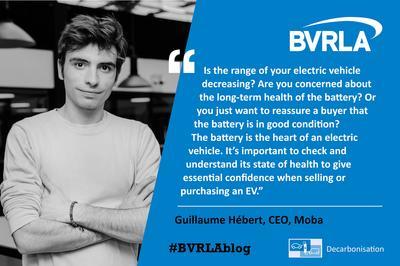Guillaume Hébert, Co-Founder and CEO at associate member and electric vehicle data specialist Moba discusses the importance of battery certification at the re-sale stage and provides a few tips for keepings EVs in good health.

Is the range of your electric vehicle decreasing? Are you concerned about the long-term health of the battery? Or you just want to reassure a buyer that the battery is in good condition?
The battery is the heart of an electric vehicle. It’s important to check and understand its state of health to give essential confidence when selling or purchasing an EV.
An EV has two batteries: a 12V battery for powering accessories, equivalent to the battery of internal combustion engine (ICE) vehicles, and a battery pack which powers the car's electric motor. The battery pack is made up of dozens of small batteries or cells, connected together. As an electric vehicle ages, it degrades, causing the vehicle to lose range.
This loss is due to the chemical degradation of the cells that make up the battery pack. The rate and impact of this degradation are highly dependent on the conditions of use and storage of the vehicle. For example, high temperatures or fast charging accelerate the aging of batteries.
The state of the battery is measured using a term called State of Health. The State of Health (SOH) is presented as a percentage. This figure gives a picture of the degradation to give the owner or operator a more accurate picture of how that vehicle will perform.
The SOH percentage is calculated against the maximum electrical energy that a battery can provide at a given time and the maximum electrical energy that it could provide when leaving the factory. For example, the SOH of a new electric vehicle is 100%. The Battery Management System (BMS) regularly checks the state of the battery and calculates the SOH. For the driver or operator, it is essential to regularly measure the SOH in order to ensure normal degradation, or to adapt how they use it in the event of premature aging.
At Moba, we have an app for operators that allows for multi-brand diagnostic application and the production of battery health certification.
We’re often asked if plugging in the testing box is safe. The Moba testing box is merely a reader, it simply communicates with the vehicle to collect the required information. It can in no way alter or disrupt the car’s settings.
The certificate includes a complete report on the battery, its current SoH, important indicators to help understand the results, and theoretical range predictions for summer and winter. These details combine to provide all the essential information needed when selling or purchasing an EV.
Batteries for EVs are expensive to replace, so it is important to check and understand their condition when purchasing a used EV. Ask for the car's maintenance history to make sure it has been properly serviced and check if it has been involved in an accident. Make sure you understand charging and maintenance costs to avoid unpleasant surprises.
When it comes to electric vehicles, members and fleet operators are recommended to remind their drivers of best practice. This includes:
- Plan trips in advance to ensure that the battery will not run out before reaching the destination
- Keep battery charge at an appropriate level and charged at an appropriate speed
- Avoid leaving EV parked for long periods of time with a low or too high charge, as this can damage the battery
- Follow manufacturer's recommendations for battery maintenance and charging to extend battery life
- Smooth driving and braking energy recovery can improve the range of an EV.
To re-sell a used EV, it is important to prepare all the necessary documents, such as the registration certificate and maintenance history and obtain a battery certificate to ensure a straightforward and fast sale.





